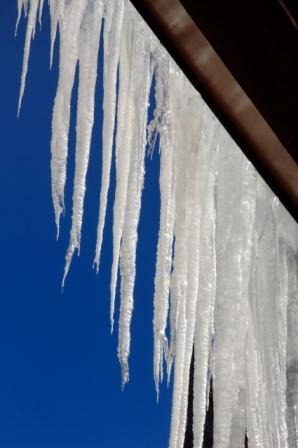Icicles hanging along the eaves of your house may look beautiful, but they spell trouble. That is because the same conditions that allow icicles to form— snow-covered roofs and freezing weather—also lead to ice dams. Ice dams are thick ridges of solid ice that build up along the eaves. Dams can tear off gutters, loosen shingles, and cause water to back up and pour into your house. When that happens? The results aren't pretty... peeling paint, warped floors, stained and sagging ceilings. Not to mention soggy insulation in the attic, which loses R-value and becomes a magnet for mold and mildew.
snow-covered roofs and freezing weather—also lead to ice dams. Ice dams are thick ridges of solid ice that build up along the eaves. Dams can tear off gutters, loosen shingles, and cause water to back up and pour into your house. When that happens? The results aren't pretty... peeling paint, warped floors, stained and sagging ceilings. Not to mention soggy insulation in the attic, which loses R-value and becomes a magnet for mold and mildew.
Birth of an Ice Dam
1. Heat collects in the attic and warms the roof, except at the eaves.
2. Snow melts on the warm roof and then freezes on the cold eaves.
3. Ice accumulates along the eaves, forming a dam. Melting water from the warm roof backs up behind it, flows under the shingles, and into the house.
Fast Fixes
Hacking away at ice dams with a hammer, chisel, or shovel is bad for your roofing—and dangerous for you. In addition, throwing salt on them will do more to harm your plantings than to harm the ice. Short of praying for warm weather, here are two measures we recommend:
1) Removing the snow from the roof can help slow down dam growth. On very low-sloped or flat roofs, some folks shovel off all the snow! On a roof with a greater pitch, removing three or four feet of snow above the roofline will slow down the growth of the dam. There is a special tool for removing snow called a roof rake. Roof rakes are great to use if the show is light and not very crusty. They also are somewhat dangerous to use on ladders. Watch for electrical lines and for falling snow from the roof.
2) Chisel grooves into the dam to allow the water behind it to drain off. This is a good emergency measure... especially if rain or a sudden thaw is coming! Careful with those shingles. I advise hiring a professional to handle the issue.
How Can I Prevent Ice Dams in the Future?
Properly ventilating and insulating the attic is usually the best way to prevent ice dams. The usual recommendation for proper ventilation is 1 square foot of vent for every 150 feet of attic floor area. Each climate region may have it's own recommendations, though, so I would suggest contacting a licensed local insulation company near you. If you have small louvered vents at either end of the attic known as gable vents you can either replace them with larger vents, or install an electric vent fan over the inside of them. These special fans usually work on a thermostat and will pull outside air into the attic to keep the temperature inside consistent.